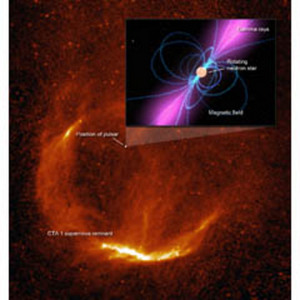May 8, 2009 Research Highlight Physics / Astronomy
Pinpointing pulsars
The new Fermi Gamma-Ray Space Telescope has identified a new pulsar by detecting its gamma-ray emission
 Figure 1: A pulsar (inset) that lies in the CTA1 supernova remnant and beams only in gamma rays. This pulsar was discovered by NASA’s Gamma-ray Space Telescope. Credit: NASA/S. Pineault, DRAO
Figure 1: A pulsar (inset) that lies in the CTA1 supernova remnant and beams only in gamma rays. This pulsar was discovered by NASA’s Gamma-ray Space Telescope. Credit: NASA/S. Pineault, DRAO
A massive star can die when its core collapses in on itself, causing an explosion called a supernova. Some of the most important remnants of supernovae are pulsars—extremely dense stars composed mainly of neutrons.
Now, a new pulsar has been discovered by an international collaboration of researchers using the Fermi Gamma-Ray Space Telescope1, which was launched in June 2008. The researchers, including Nobuyuki Kawai at RIKEN’s Advanced Science Institute in Wako, hope that this new pulsar could help to explain several unidentified gamma ray sources throughout the galaxy.
Pulsars get their name because they are highly magnetized and rotate at great speeds to emit beams of electromagnetic radiation in pulses. These pulses are so regular they have been compared to the accuracy of an atomic clock.
Many pulsars are associated with supernovae remnants; for example the famous Crab nebula is fed by a wind of relativistic particles from an energetic pulsar at its center.
Kawai and co-workers discovered their new pulsar in a supernova remnant called CTA 1 (Fig. 1), which is relatively young having exploded between 5,000 and 15,000 years ago. CTA 1 was previously studied using the EGRET telescope on NASA’s Compton Gamma Ray Observatory satellite, but this device was not capable of proving the existence of a pulsar.
The Large Area Telescope on the new Fermi satellite is more sensitive and can probe much higher energies than EGRET. The researchers were able to record just over 900 gamma-ray photons from CTA 1 before the Fermi telescope was even fully calibrated. They observed significant pulsations in the gamma radiation, occurring at intervals of 317 milliseconds.
The researchers calculated that the pulsar is roughly 14,000 years old, by assuming that it has been losing speed over its lifetime by emitting radiation. They also found that it has the second-highest magnetic field of known gamma-ray pulsars.
In the past, most pulsars were identified by observing pulsations in their radio-frequency emissions. However the researchers recorded no radio signal from the pulsar in CTA 1, probably because it emits a narrow beam of radio waves that is not in the line of sight of the telescope. This implies that there are many other ‘gamma-ray-loud but radio-quiet’ pulsars that could now be verified by recording gamma rays with the Fermi telescope.
In their paper, published in Science, the researchers say: “This pulsar detection implies that many of the yet-unidentified low latitude Galactic gamma-ray sources also could be pulsars.”
References
- 1. Abdo, A.A., Ackermann, M., Atwood, W.B., Baldini, L., Ballet, J., Barbiellini, G., Baring, M.G., Bastieri, D., Baughman, B.M., Bechtol, K., et al. The Fermi Gamma-Ray Space Telescope discovers the pulsar in the young galactic supernova remnant CTA 1. Science 322, 1218–1221 (2008). doi: 10.1126/science.1165572
